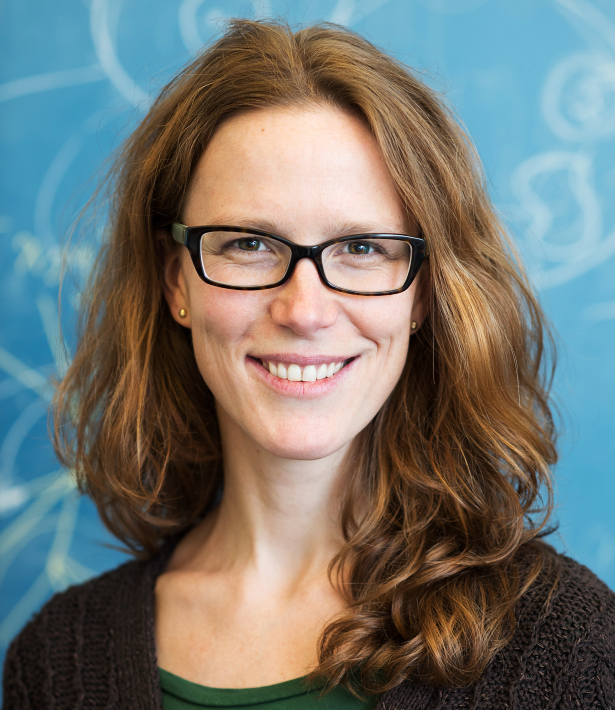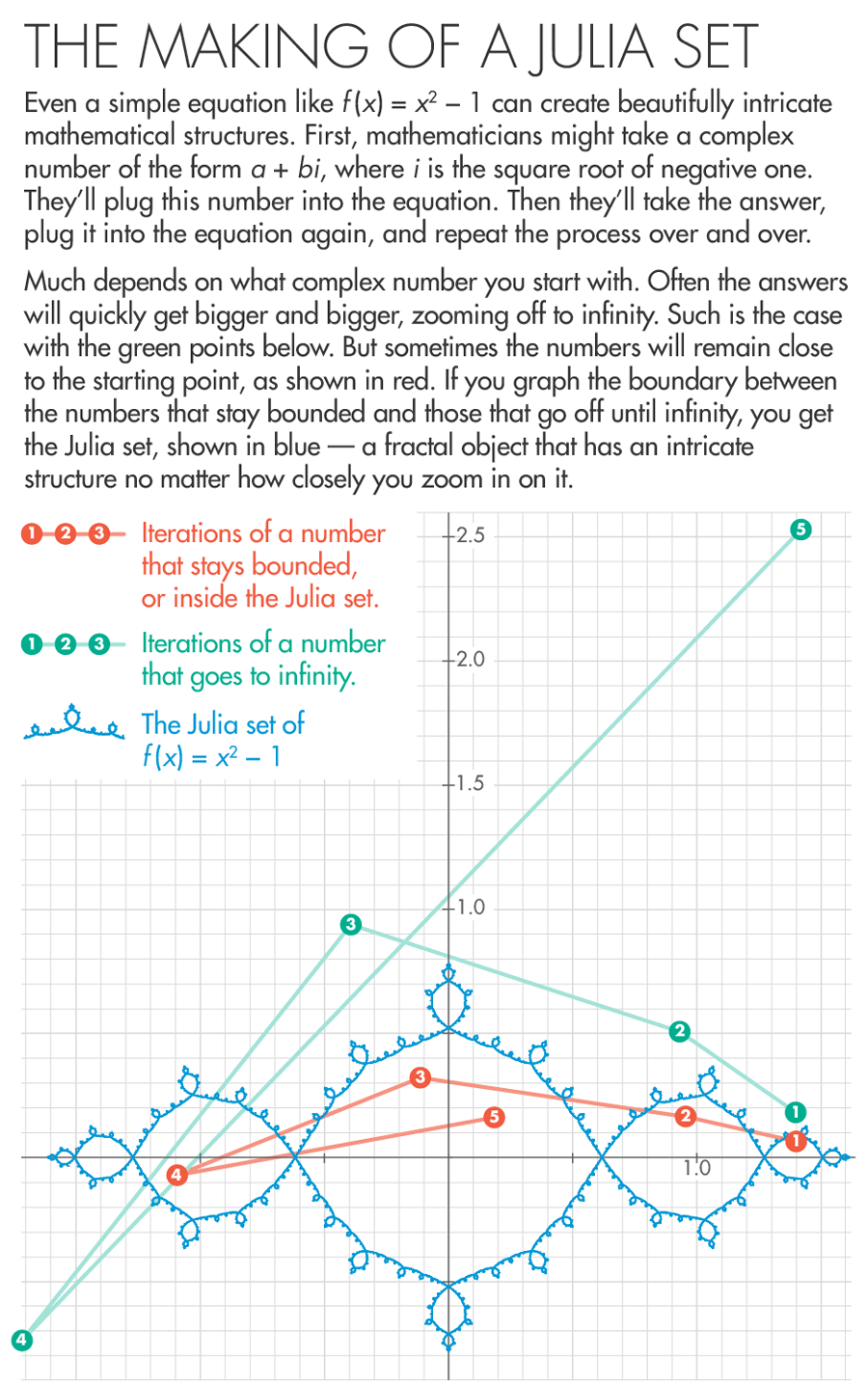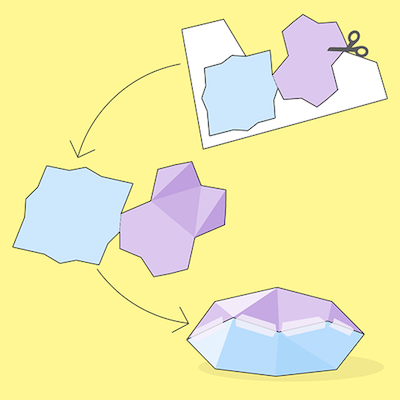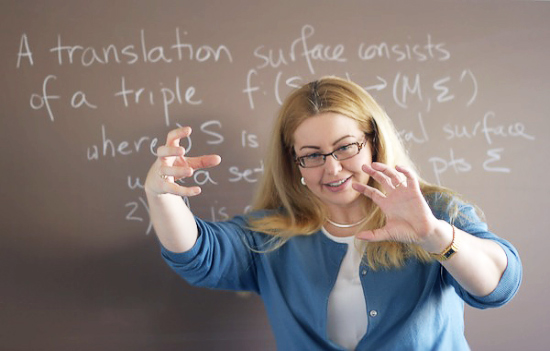3-D Fractals Offer Clues to Complex Systems

Olena Shmahalo/Quanta Magazine; original figure by Laurent Bartholdi and Laura DeMarco
Introduction
If you came across an animal in the wild and wanted to learn more about it, there are a few things you might do: You might watch what it eats, poke it to see how it reacts, and even dissect it if you got the chance.
Mathematicians are not so different from naturalists. Rather than studying organisms, they study equations and shapes using their own techniques. They twist and stretch mathematical objects, translate them into new mathematical languages, and apply them to new problems. As they find new ways to look at familiar things, the possibilities for insight multiply.
That’s the promise of a new idea from two mathematicians: Laura DeMarco, a professor at Northwestern University, and Kathryn Lindsey, a postdoctoral fellow at the University of Chicago. They begin with a plain old polynomial equation, the kind grudgingly familiar to any high school math student: f(x) = x2 – 1. Instead of graphing it or finding its roots, they take the unprecedented step of transforming it into a 3-D object.
With polynomials, “everything is defined in the two-dimensional plane,” Lindsey said. “There isn’t a natural place a third dimension would come into it until you start thinking about these shapes Laura and I are building.”

How Curvature Makes a Shape a Shape
The 3-D shapes that they build look strange, with broad plains, subtle bends and a zigzag seam that hints at how the objects were formed. DeMarco and Lindsey introduce the shapes in a forthcoming paper in the Arnold Mathematical Journal, a new publication from the Institute for Mathematical Sciences at Stony Brook University. The paper presents what little is known about the objects, such as how they’re constructed and the measurements of their curvature. DeMarco and Lindsey also explain what they believe is a promising new method of inquiry: Using the shapes built from polynomial equations, they hope to come to understand more about the underlying equations — which is what mathematicians really care about.
Breaking Out of Two Dimensions
In mathematics, several motivating factors can spur new research. One is the quest to solve an open problem, such as the Riemann hypothesis. Another is the desire to build mathematical tools that can be used to do something else. A third — the one behind DeMarco and Lindsey’s work — is the equivalent of finding an unidentified species in the wild: One just wants to understand what it is. “These are fascinating and beautiful things that arise very naturally in our subject and should be understood!” DeMarco said by email, referring to the shapes.

“It’s sort of been in the air for a couple of decades, but they’re the first people to try to do something with it,” said Curtis McMullen, a mathematician at Harvard University who won the Fields Medal, math’s highest honor, in 1988. McMullen and DeMarco started talking about these shapes in the early 2000s, while she was doing graduate work with him at Harvard. DeMarco then went off to do pioneering work applying techniques from dynamical systems to questions in number theory, for which she will receive the Satter Prize — awarded to a leading female researcher — from the American Mathematical Society on January 5.
Meanwhile, in 2010 William Thurston, the late Cornell University mathematician and Fields Medal winner, heard about the shapes from McMullen. Thurston suspected that it might be possible to take flat shapes computed from polynomials and bend them to create 3-D objects. To explore this idea, he and Lindsey, who was then a graduate student at Cornell, constructed the 3-D objects from construction paper, tape and a precision cutting device that Thurston had on hand from an earlier project. The result wouldn’t have been out of place at an elementary school arts and crafts fair, and Lindsey admits she was kind of mystified by the whole thing.
“I never understood why we were doing this, what the point was and what was going on in his mind that made him think this was really important,” said Lindsey. “Then unfortunately when he died, I couldn’t ask him anymore. There was this brilliant guy who suggested something and said he thought it was an important, neat thing, so it’s natural to wonder ‘What is it? What’s going on here?’”
In 2014 DeMarco and Lindsey decided to see if they could unwind the mathematical significance of the shapes.
A Fractal Link to Entropy
To get a 3-D shape from an ordinary polynomial takes a little doing. The first step is to run the polynomial dynamically — that is, to iterate it by feeding each output back into the polynomial as the next input. One of two things will happen: either the values will grow infinitely in size, or they’ll settle into a stable, bounded pattern. To keep track of which starting values lead to which of those two outcomes, mathematicians construct the Julia set of a polynomial. The Julia set is the boundary between starting values that go off to infinity and values that remain bounded below a given value. This boundary line — which differs for every polynomial — can be plotted on the complex plane, where it assumes all manner of highly intricate, swirling, symmetric fractal designs.

“The Julia set is the base, like the southern hemisphere, and the cap is like the top half,” DeMarco said. “If you glue them together you get a shape that’s polyhedral.”
The algorithm was Thurston’s idea. When he suggested it to Lindsey in 2010, she wrote a rough version of the program. She and DeMarco improved on the algorithm in their work together and “proved it does what we think it does,” Lindsey said. That is, for every filled Julia set, the algorithm generates the correct complementary piece.
The filled Julia set and the planar cap are the raw material for constructing a 3-D shape, but by themselves they don’t give a sense of what the completed shape will look like. This creates a challenge. When presented with the six faces of a cube laid flat, one could intuitively know how to fold them to make the correct 3-D shape. But, with a less familiar two-dimensional surface, you’d be hard-pressed to anticipate the shape of the resulting 3-D object.
“There’s no general mathematical theory that tells you what the shape will be if you start with different types of polygons,” Lindsey said.
Mathematicians have precise ways of defining what makes a shape a shape. One is to know its curvature. Any 3-D object without holes has a total curvature of exactly 4π; it’s a fixed value in the same way any circular object has exactly 360 degrees of angle. The shape — or geometry — of a 3-D object is completely determined by the way that fixed amount of curvature is distributed, combined with information about distances between points. In a sphere, the curvature is distributed evenly over the entire surface; in a cube, it’s concentrated in equal amounts at the eight evenly spaced vertices.
A unique attribute of Julia sets allows DeMarco and Lindsey to know the curvature of the shapes they’re building. All Julia sets have what’s known as a “measure of maximal entropy,” or MME. The MME is a complicated concept, but there is an intuitive (if slightly incomplete) way to think about it. First, picture a two-dimensional filled Julia set on the plane. Then picture a point on the same plane but very far outside the Julia set’s boundary (infinitely far, in fact). From that distant location the point is going to take a random walk across two-dimensional space, meandering until it strikes the Julia set. Wherever it first strikes the Julia set is where it comes to rest.

Can you turn a two-dimensional fractal into a 3-D object? Break out your scissors and tape for a chance to win a 3-D printed sculpture.
The MME is a way of quantifying the fact that the meandering point is more likely to strike certain parts of the Julia set than others. For example, the meandering point is more likely to strike a spike in the Julia set that juts out into the plane than it is to intersect with a crevice tucked into a region of the set. The more likely the meandering point is to hit a point on the Julia set, the higher the MME is at that point.
In their paper, DeMarco and Lindsey demonstrated that the 3-D objects they build from Julia sets have a curvature distribution that’s exactly proportional to the MME. That is, if there’s a 25 percent chance the meandering point will hit a particular place on the Julia set first, then 25 percent of the curvature should also be concentrated at that point when the Julia set is joined with the planar cap and folded into a 3-D shape.
“If it was really easy for the meandering point to hit some area on our Julia set we’d want to have a lot of curvature at the corresponding point on the 3-D object,” Lindsey said. “And if it was harder to hit some area on our Julia set, we’d want the corresponding area in the 3-D object to be kind of flat.”
This is useful information, but it doesn’t get you as far as you’d think. If given a two-dimensional polygon, and told exactly how its curvature should be distributed, there’s still no mathematical way to identify exactly where you need to fold the polygon to end up with the right 3-D shape. Because of this, there’s no way to completely anticipate what that 3-D shape will look like.
“We know how sharp and pointy the shape has to be, in an abstract, theoretical sense, and we know how far apart the crinkly regions are, again in an abstract, theoretical sense, but we have no idea how to visualize it in three dimensions,” DeMarco explained in an email.
She and Lindsey have evidence of the existence of a 3-D shape, and evidence of some of that shape’s properties, but no ability yet to see the shape. They are in a position similar to that of astronomers who detect an unexplained stellar wobble that hints at the existence of an exoplanet: The astronomers know there has to be something else out there and they can estimate its mass. Yet the object itself remains just out of view.
A Folding Strategy
Thus far, DeMarco and Lindsey have established basic details of the 3-D shape: They know that one 3-D object exists for every polynomial (by way of its Julia set), and they know the object has a curvature exactly given by the measure of maximal entropy. Everything else has yet to be figured out.
In particular, they’d like to develop a mathematical understanding of the “bending laminations,” or lines along which a flat surface can be folded to create a 3-D object. The question occurred early on to Thurston, too, who wrote to McMullen in 2010, “I wonder how hard it is to compute or characterize the pair of bending laminations, for the inside and the outside, and what they might tell us about the geometry of the Julia set.”

In this, DeMarco and Lindsey’s work is heavily influenced by the mid 20th-century mathematician Aleksandr Aleksandrov. Aleksandrov established that there is only one unique way of folding a given polygon to get a 3-D object. He lamented that it seemed impossible to mathematically calculate the correct folding lines. Today, the best strategy is often to make a best guess about where to fold the polygon — and then to get out scissors and tape to see if the estimate is right.
“Kathryn and I spent hours cutting out examples and gluing them ourselves,” DeMarco said.
DeMarco and Lindsey are currently trying to describe the folding lines on their particular class of 3-D objects, and they think they have a promising strategy. “Our working conjecture is that the folding lines, the bending laminations, can be completely described in terms of certain dynamical properties,” DeMarco said. Put another way, they hope that by iterating the underlying polynomial in the right way, they’ll be able to identify the set of points along which the folding line occurs.
From there, possibilities for exploration are numerous. If you know the folding lines associated to the polynomial f(x) = x2 – 1, you might then ask what happens to the folding lines if you change the coefficients and consider f(x) = x2 – 1.1. Do the folding lines of the two polynomials differ a little, a lot or not at all?
“Certain polynomials might have similar bending laminations, and that would tell us all these polynomials have something in common, even if on the surface they don’t look like they have anything in common,” Lindsey said.
It’s a bit early to think about all of this, however. DeMarco and Lindsey have found a systematic way to think about polynomials in 3-D terms, but whether that perspective will answer important questions about those polynomials is unclear.
“I would even characterize it as being sort of playful at this stage,” McMullen said, adding, “In a way that’s how some of the best mathematical research proceeds — you don’t know what something is going to be good for, but it seems to be a feature of the mathematical landscape.”
Try your hand at shaping a two-dimensional fractal into a 3-D polyhedron.
This article was reprinted on Wired.com.





